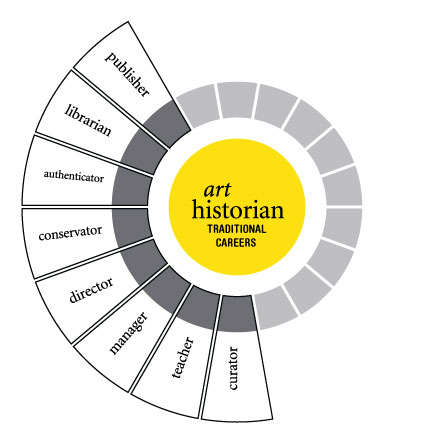What Jobs Can You Get With an Art History Degree
The Top Eight Traditional Careers in Fine art History
Graduates of art history degree programs emerge primed for a wide range of careers in the fine art field and beyond. While many art historians cull cocky-employed fine arts jobs or nontraditional art history careers, the following sought-later careers in art history represent the peak viii traditional uses for an art history main'south degree:

1. Curator
A curator oversees the drove, storage, and display of artworks, historical memorabilia, digital files, or artifacts. Depending upon the size of the system, curators may exist responsible for working with artists, collectors, donors, or other organizations to acquire artwork; documentation and storage; original research and publication; and creative display of works. Traditionally, curators piece of work for museums, libraries, and other arts organizations. However, in recent years this role has expanded to include business curators managing corporate memorabilia and art collections, curation for educational institutions, private foundation or personal collection curators, government curators working with public spaces, and independent, freelance curators.
2. Teacher
Art history educators share art knowledge in museum or academic settings. Depending upon the specific role and organization, level of audience, and specialty, art history educators may spend significant time conducting research, interacting with the public, or mentoring art students in the classroom.
iii. Museum Administrator/Director
Museum directors comport ultimate responsibility for advancing their arrangement's mission, artistic direction, collections, scholarship, and programs. The manager manages the museum's day-to-day operations. Similar curators, directors influence creative management of the museum'southward exhibitions and oversee the drove, storage, and display of artworks. In improver, museum directors manage the administrative side of the arrangement. An administrator's task typically includes a significant amount of fundraising, donor and community relations, fiscal and investment management, hiring, and oversight of museum staff.
4. Conservator/Fine art Restorer/Conservation Scientist
Art conservators specialize in the preservation, care, and restoration of works of art. Conservators manage the rubber storage and transportation of works, clarify the display surroundings, document and tape electric current condition, and decide restoration efforts needed. Patience and attention to detail are critical in this office. Conservators typically choose an expanse of expertise, such as paper, textiles, painting, furniture, or art objects. They often piece of work closely with conservation scientists—chemists who concern themselves with the scientific elements at work in an art piece'south environment and composition, and in the chemical components of the restoration and preservation procedure.
five. Art Authenticator
The sophistication of art forgers, the prevalence of art theft, and the unlawful transfer of artworks from war-torn countries ways that potential art buyers and sellers often require the authentication services of an fine art historian. Typically, authenticators specialize in a particular creative person or way, and must brandish substantial enquiry and investigative skills. Authenticators research the "provenance" of a work by tracing the path of buying as far back as possible, piece of work with other recognized experts, consult with artists' foundations, and contract scientific testing to decide the viability of the materials used.
6. Museum Reproductions/Retail Managing director
A museum reproductions function tin involve museum store retail management and decision-making regarding which artworks in the museum'southward collections should exist reproduced for sale. Information technology may include working with artists and navigating copyright issues, pattern and artistic decisions for the display and reproduction of the artwork in the retail setting, managing sales staff, and other duties related to running the retail arm of an arts arrangement.
seven. Fine art Librarian/Visual Resource Curator
Visual resource curators and fine art librarians manage the cataloguing, documentation, storage, and retrieval of visual resources in art libraries, educational institutions, and for-turn a profit organizations. In addition to expertise in the artwork itself, art librarians bring research and technological skills to the office, forth with the people skills necessary to work with the public and academicians equally they access the works. In addition to a graduate degree in art history, art librarianship roles may require graduate piece of work in library science.
8. Art Publishing
Academic, commercial, and independent art volume publishing houses use a range of arts professionals in graphic design, writing, editing, and administrative roles. While entry level roles typically will not crave a master's degree, advancement in these roles often requires higher didactics in the arts, and these roles will provide opportunities to explore and influence art history dialogue and estimation.
9. Auctioneer
An auctioneer represents the seller of a piece of art. The auctioneer must creatively describe the piece and create excitement during an sale in order to sell it for the highest price possible. Auctioneers frequently research particular art pieces to proceeds knowledge nigh the artwork itself, and additionally must have the power to remain cool nether force per unit area, relate to art owners, and read a crowd.
For more information, visit Azusa Pacific University'south Online MA in Modern and Contemporary Art History.
For more careers in fine art history, check out these related resource:
- The Elevation 9 Nontraditional Art History Careers
- The Top Seven Self-Employed Arts Jobs for Art Historians
Notation: This information is electric current for the 2021-22 academic yr; nonetheless, all stated academic information is subject to change. Please refer to the electric current Bookish Itemize for more information.
Source: https://www.apu.edu/vpa/programs/art-history-masters/careers/traditional/
0 Response to "What Jobs Can You Get With an Art History Degree"
Publicar un comentario